prasad1
Active member
I reposting an older article.
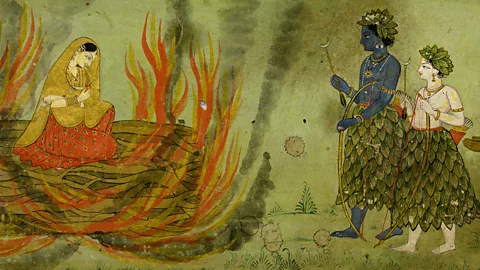
Indian myths (Credit: British Museum)
Modern writers are retelling India’s legendary Hindu tales – often through a feminist lens. Why is this important? Akanksha Singh takes a look.
Storytelling is an innately human quality; one that crosses cultures and languages. Just as my sister and I huddled together as children while our mother read to us each night, so too did our forebears. “We do not lend the hearth quite the importance that our ancestors did, Greek or otherwise,” Stephen Fry writes in Mythos: The Greek Myths Retold. It was the hearth where ancient humans gathered to keep warm, and as they did they talked, sang and laughed. In other words, they told stories. Myths are the most fulfilling form of storytelling: they serve to document events; explain the unexplainable; to operate as manuals for morality.
While myths are being made new, they grow to represent both the worlds they were set in and today. Take for example the figures of Eve, Madonna, Helen, and Penelope – all embodiments of women invented by men. “Words, our primary agent of expression,” Christine C Keating points out in her essay, Unearthing the Goddess Within: “signify a discourse that has been established by a patriarchic myth.” We were given these characters, with their beauty and flaws, by men. And while feminist revisionist literature has tackled the issue, it’s never been more important – in a post-#MeToo world – to imagine new characters and rethink existing ones. Language has evolved to consider everything from the uniqueness of the feminine experience to what it means to be female anatomically. And in literature there has been a resurgence of feminist retellings of myths, especially in Classical mythology. In the original version of Virgil's The Aeneid, Lavinia never speaks; in Ursula K Le Guin’s 2008 version, she is the titular character, this time with a voice. And Madeline Miller’s Circe and Pat Barker’s The Silence of the Girls both made the shortlist for the Women’s Prize for Fiction this year.
A similar change is happening in India. The only difference here is that stories from Hindu mythology born thousands of years ago – including religious epics like the Ramayana and the Mahabharata – remain largely unchanged compared to the ones told in India today. Hinduism is one of the world’s oldest surviving religions: its teachings, legends and myths are integrated into the culture, the education system, and the society at large. And since Hinduism has existed (and continues to exist) within the borders of what is modern-day India, it is inevitable that lines are blurred. You’ll find festivals like Diwali and Holi being celebrated by everyone – not just Hindus. Where Hindu women wore mangalsutras (wedding necklaces) instead of wedding bands, Christian women (notably in Mangalore) adopted this tradition. And much like children study the Greeks, Hindu mythology is taught in schools.
‘Drastic shifts’
A decade ago, the Ramayana – the story of the prince, Rama – was fairly standard. At the request of his stepmother, Rama is exiled for 14 years by his father Dasaratha, the king of Ayodhya. Rama and his wife Sita live in the forest, with his stepbrother Laksmana. When Sita is abducted by the King of Lanka, a demon with 10 heads named Ravana, Rama goes through extreme efforts to save his wife, kill Ravana, and return to his kingdom on a new-moon night. To welcome him, the villagers of the kingdom light lamps and candles. A family is reunited and good has triumphed over evil. On the same new moon each year, Hindus celebrate Diwali. While some versions change certain mechanisms within the plot – in one version, Sita is Ravana’s daughter, for example – the nuts and bolts of the plot remain the same. Recent years, however, have seen drastic shifts in Hindu, myth-centric literature. These shifts all stem from retelling age-old tales through a feminist lens.
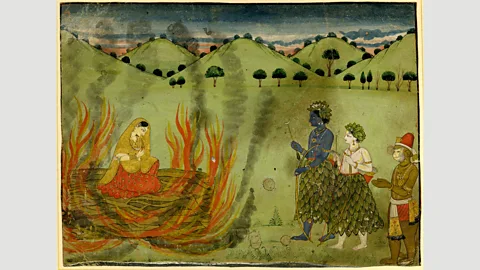
This scene from the Ramayana depicts Sita undergoing the ordeal by fire to test her chastity (Credit: British Museum)
Take, for instance, the Panchakanya or ‘Five Virgins’ – five iconic heroines from mythology who are enshrined in a Sanskrit verse that reads: “Ahalya, Draupadi, Kunti, Tara, Mandodari tatha / Panchakanya smaren nityam, mahapatak naashaka.” Roughly translated, it reads: “Ahalya, Draupadi, Kunti, Tara and Mandodari / Invoking daily the virgins five / Destroys the greatest sins.”
Of the five virgins, Kunti and Draupadi are characters from the Mahabharata, and Ahalya, Tara, and Mandodari are from the Ramayana. None of these five women are actually virgins: their ‘scandalous’ stories, of polyandry and public disrobing (Draupadi); manipulation of men and kingdoms (Kunti); origins as celestial nymphs and demons (Tara and Mandodari) and adultery and punishment (Ahalya) were largely seen – until recently – as cautionary tales.
It is no surprise that modern retellings of stories from the Ramayana are told from Sita’s point of view
The ultimate bar for the ‘good housewife’ in the Indian Hindu context remains Sita – the subservient wife of Rama who follows him into exile in the jungle. But, as Linda Hess points out in Rejecting Sita: Indian Responses to the Ideal Man's Cruel Treatment of His Ideal Wife, there are great differences in the bars set for these characters: “[At] the end of the great war between [Rama] and the demons, [Sita] must undergo a test of chastity that requires her to throw herself into a blazing fire.” Most popular versions of the Ramayana, Hess points out, omit these stories altogether, ending instead with Rama and Sita in the golden age of Rama’s rule in Ayodhya. Similarly, renowned Indian feminists, Kamla Bhasin and Ritu Menon, note that after the famed 1980s adaptation of the epic, with Sita as the ideal: “[the] overarching ideology [of] female dispensability,” violence against women in India – whether physical, sexual or emotional – remains normalised.
Feminist icons?
It is no surprise that modern retellings of stories from the Ramayana are told from Sita’s point of view. Among these are Sita: Daughter of the Earth – A Graphic Novel by Saraswati Nagpal, The Girl Who Chose: A New Way of Narrating the Ramayana, Sita: An Illustrated Retelling of the Ramayana by Devdutt Pattanaik, and Sita: The Warrior of Mithila by Amish Tripathi. The last two authors listed are men. The field of Hindu mythology, and indeed Indian publishing itself, is male-dominated. Amish Tripathi is known for his modern retellings of Hindu myths, many of which are bestsellers, but his reimagining of Sita comes with a degree of what could be described as ‘mansplaining’. In an interview with the Hindustan Times, Tripathi said he intended for readers: “to see Sita as a feminist icon” and “see her as a warrior, not just her physical strength but also her mental ability.” Devdutt Pattanaik, on the other hand, is a mythologist first and foremost. His rendering tells the Ramayana through Sita’s point of view, but his narrative is limited to the constraints of an original version of the Ramayana by Valmiki.
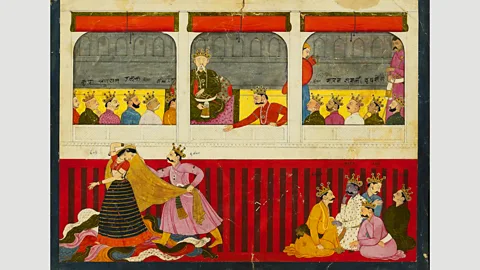
A key scene in the Mahabharata is the disrobing of Drapaudi, who is gambled on and lost in a game of dice (Credit: Alamy)
While ancient myths are products of their time, they evolve, too. Between reprints and verbal iterations (which is how these myths were initially passed down), changes in the narrative are inevitable. To restrict retellings in the ‘purest’ form of mythology as Patnaik does is to ignore the manner in which society itself functions and is changing. To rewrite a prominent myth today, and ignore the social shifts India has undergone – particularly as far as women are concerned – does both the retelling and the reader an injustice. Especially when it concerns a female character who has been lauded as an “ideal wife” and a “model for womanhood”, as Sita was by Mohammad Hidayatullah, the 11th Chief Justice of India during an international conference on the Ramayana.
In Divakaruni’s version, this very meek, wronged character, who has been humiliated and harassed in a distinctly gendered manner, has a strong voice for change
It is the character of Draupadi from The Mahabharata however – the most enigmatic of the five ‘virgins’ – who has had tens of books rewrite the story from her point of view. The most popular of these, at least in English, is Chitra Banerjee Divakaruni’s The Palace of Illusions. The Mahabharata is, as far as epics go, hyper-masculine. Two related families – the Kauravas and the Pandavas – fight in the Kurukshetra War for the Hastinapura throne. Cue the thunder of chariots, bows spewing arrows in all directions, and utter mayhem for 1.8 million words. There is a key scene in the Mahabharata in which Draupadi, who is the wife of all five Pandava brothers, is gambled away and lost in a game of dice. She is summoned from her bath by Duryodhana, a winning Kaurava. When she arrives partially dressed, his brother Dushasana mocks her chastity on account of her many husbands, and starts unrolling her ekavastra (a saree without a petticoat or blouse). She prays to Krishna to preserve her dignity, and he does so by ensuring her ekavastra never stops unrolling.
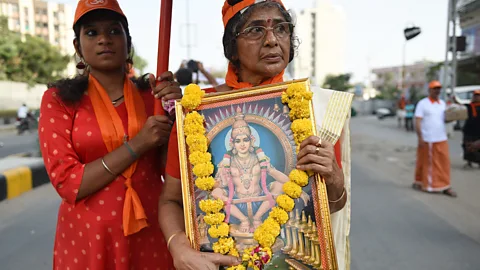
Religious devotees protested against India’s decision to revoke a ban on women aged between 10 and 50 entering a Hindu temple in Kerala (Credit: Getty)
In Divakaruni’s version, this very meek, wronged character, who has been humiliated and harassed in a distinctly gendered manner, isn’t clueless that she’s been objectified; she has a strong voice for change: “I‘m a queen. Daughter of Drupad, sister of Dhristadyumna. Mistress of the greatest palace on earth. I can‘t be gambled away like a bag of coins, or summoned to court like a dancing girl.”
This is an obvious statement for Draupadi’s character to make – but it’s an important one to make in print. As a society, India has rooted its morality in myths and theology for hundreds of years – and still has a long way to go towards the fair treatment of women today. Representation in India’s key mythologies also has a long way to go, but in retelling myths through a more balanced lens, writers can find a new story to tell.
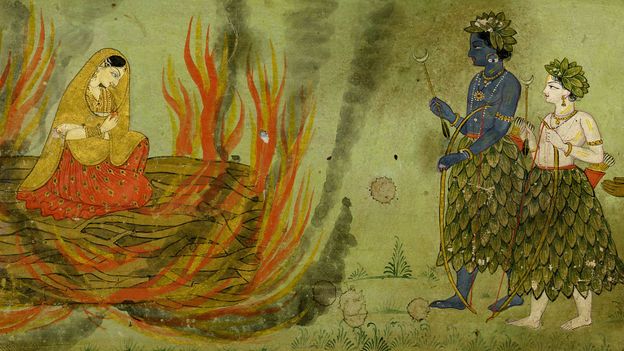
How India’s ancient myths are being rewritten
Modern writers are retelling India’s legendary Hindu tales – often through a feminist lens. Why is this important? Akanksha Singh takes a look.
